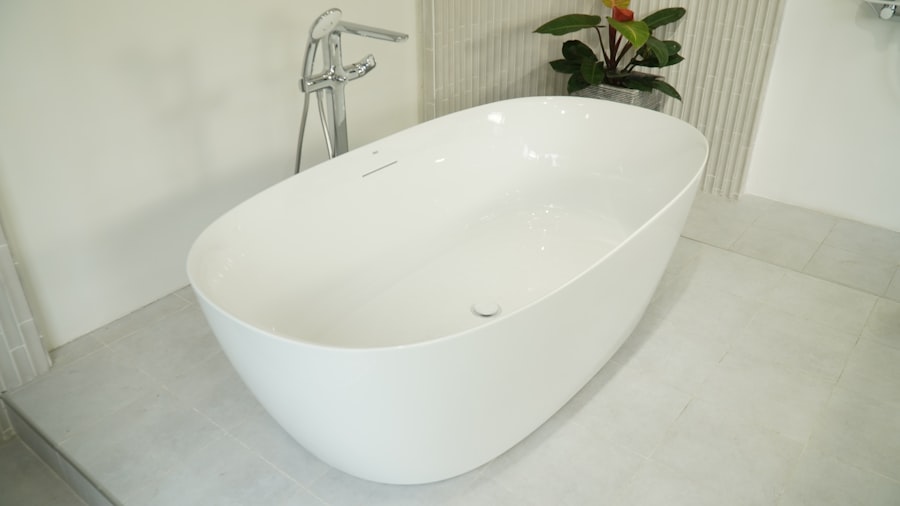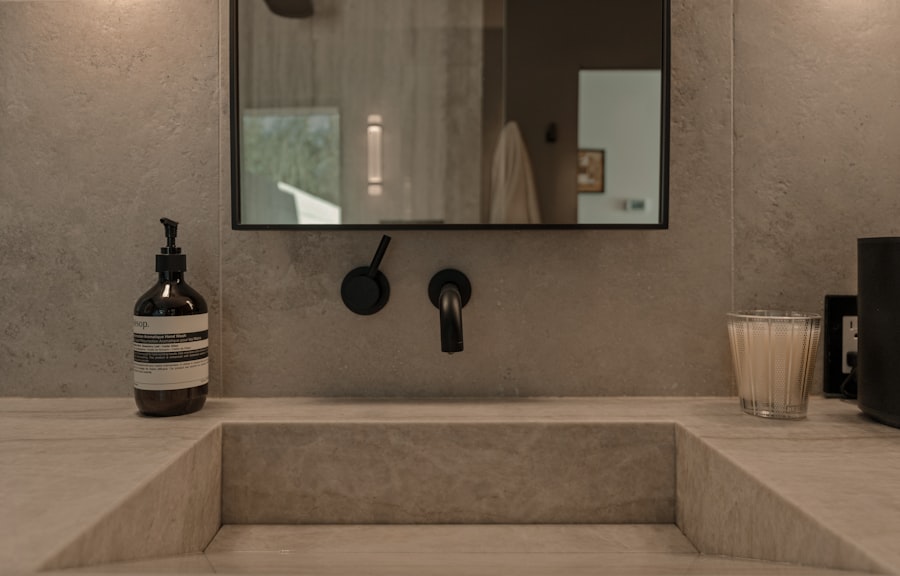The decision to replace a bathtub often stems from a variety of factors, ranging from aesthetic desires to practical needs. One of the most compelling reasons for considering a bathtub replacement is the age and condition of the existing tub. Over time, bathtubs can develop cracks, stains, and other forms of wear that not only detract from the bathroom’s appearance but can also lead to leaks and water damage.
A bathtub that has seen better days can become a source of frustration, making it less inviting for relaxation or daily use. By replacing an old tub, homeowners can enhance the overall look of their bathroom while also ensuring that it functions properly. Another significant reason to consider a bathtub replacement is the opportunity to upgrade to a more modern design or feature set.
The bathroom is often regarded as a sanctuary within the home, and an outdated bathtub can diminish that experience. Newer models come equipped with various features such as built-in jets for hydrotherapy, ergonomic designs for comfort, and materials that are easier to clean and maintain. Additionally, advancements in technology have led to the development of tubs that offer energy-efficient heating options or even smart features that allow for temperature control via smartphone apps.
This not only elevates the bathing experience but can also contribute to increased home value.
Key Takeaways
- Replacing a bathtub can improve functionality, aesthetics, and home value.
- Various types of bathtubs include acrylic, cast iron, and fiberglass, each with unique features.
- Upgrading offers benefits like enhanced comfort, modern design, and better durability.
- Important factors before replacement include size, material, plumbing, and budget.
- Hiring a professional ensures proper installation, while regular maintenance extends the tub’s lifespan.
Types of Bathtubs to Choose From
When it comes to selecting a new bathtub, homeowners are presented with a plethora of options, each catering to different preferences and needs. One popular choice is the freestanding bathtub, which has gained immense popularity in contemporary bathroom designs. These tubs are not attached to any walls and can be placed anywhere in the bathroom, allowing for greater flexibility in layout and design.
Freestanding tubs come in various shapes and sizes, from classic clawfoot designs to sleek modern silhouettes, making them a versatile option for any aesthetic. Another common type is the alcove bathtub, which is designed to fit into a three-wall enclosure. This style is particularly advantageous for smaller bathrooms where space is at a premium.
Alcove tubs often come with built-in storage options and can be paired with shower fixtures, making them a practical choice for families or individuals who prefer quick showers over long baths. Additionally, there are corner bathtubs that maximize space by fitting snugly into the corner of a room, providing a unique design element while still offering ample bathing space.
Benefits of Upgrading Your Bathtub

Upgrading your bathtub can yield numerous benefits that extend beyond mere aesthetics. One of the most immediate advantages is improved comfort and functionality. Modern bathtubs are designed with user experience in mind, featuring ergonomic shapes that support the body better than older models.
For instance, many contemporary bathtubs have deeper basins that allow for more immersive soaking experiences, which can be particularly appealing after a long day. Furthermore, upgraded tubs often include features such as built-in armrests and headrests, enhancing relaxation during bath time. In addition to comfort, upgrading your bathtub can also lead to increased energy efficiency.
Many new bathtubs are constructed from materials that retain heat better than older models, allowing for longer baths without the need for constant reheating of water. This not only conserves energy but also contributes to lower utility bills over time. Moreover, modern bathtubs often come with advanced drainage systems that prevent clogs and promote faster water removal, making maintenance easier and more efficient.
Factors to Consider Before Replacing Your Bathtub
| Factor | Description | Considerations | Impact |
|---|---|---|---|
| Cost | Overall expense of bathtub replacement | Price of new tub, installation fees, plumbing adjustments | High – affects budget and project feasibility |
| Material | Type of bathtub material | Acrylic, cast iron, fiberglass, steel, stone resin | Medium – influences durability, weight, and maintenance |
| Size & Fit | Dimensions and compatibility with bathroom space | Measure existing space, doorways, and plumbing location | High – ensures proper installation and usability |
| Style & Design | Visual appearance and bathtub type | Freestanding, alcove, corner, clawfoot, drop-in | Medium – affects bathroom aesthetics and functionality |
| Installation Time | Duration required to complete replacement | Complexity of removal, plumbing work, and finishing | Low to Medium – impacts convenience and scheduling |
| Durability | Expected lifespan and resistance to wear | Material quality, finish, and maintenance needs | High – affects long-term value and replacement frequency |
| Maintenance | Ease of cleaning and upkeep | Surface finish, stain resistance, and repairability | Medium – influences user experience and costs |
| Plumbing Compatibility | Alignment with existing plumbing setup | Drain location, faucet type, and water supply lines | High – critical for installation feasibility |
| Safety Features | Elements to prevent slips and injuries | Non-slip surfaces, grab bars, tub height | Medium – important for households with children or elderly |
| Environmental Impact | Eco-friendliness of materials and disposal | Recyclability, water efficiency, and manufacturing process | Low to Medium – relevant for sustainable choices |
Before embarking on a bathtub replacement project, several critical factors must be taken into account to ensure a successful outcome. One of the foremost considerations is the size and layout of your bathroom. It’s essential to measure the available space accurately to determine what size and style of tub will fit without overwhelming the room.
Additionally, consider how the new tub will integrate with existing fixtures such as sinks and toilets; maintaining a cohesive design is crucial for aesthetic appeal. Another important factor is plumbing compatibility. Different types of bathtubs may require specific plumbing configurations or adjustments.
For instance, if you opt for a freestanding tub, you may need to install new plumbing lines or reposition existing ones to accommodate the tub’s location. It’s advisable to consult with a plumbing professional before making any decisions to avoid unexpected complications during installation. Furthermore, consider your household’s needs; if you have young children or elderly family members, safety features such as slip-resistant surfaces or grab bars may be essential.
Cost of Bathtub Replacement
The cost of replacing a bathtub can vary significantly based on several factors including the type of tub chosen, installation complexity, and regional labor rates. On average, homeowners can expect to spend anywhere from $1,000 to $5,000 for a complete bathtub replacement project. This estimate typically includes the cost of the tub itself as well as labor costs associated with removal of the old tub and installation of the new one.
High-end models or custom installations can push this figure even higher. In addition to the initial purchase price and installation costs, it’s important to factor in potential additional expenses such as plumbing modifications or new fixtures that may be required for your new bathtub setup. For example, if you choose a model with advanced features like jets or integrated lighting, you may need to invest in electrical work or additional plumbing adjustments.
Homeowners should also consider setting aside a budget for any unforeseen issues that may arise during installation, such as water damage or mold remediation.
Hiring a Professional for Bathtub Replacement

While some homeowners may consider undertaking a bathtub replacement as a DIY project, hiring a professional contractor is often the more prudent choice. Experienced professionals bring valuable expertise to the table, ensuring that the installation is completed correctly and efficiently. They are familiar with local building codes and regulations, which can help avoid potential legal issues down the line.
Moreover, professionals have access to specialized tools and equipment that may not be readily available to the average homeowner. When selecting a contractor for your bathtub replacement project, it’s essential to conduct thorough research. Look for licensed and insured professionals with positive reviews and testimonials from previous clients.
Requesting multiple quotes can also provide insight into fair pricing and help you gauge the contractor’s level of expertise. A reputable contractor will not only handle the installation but will also offer guidance on selecting the right tub based on your specific needs and preferences.
Maintenance and Care for Your New Bathtub
Once you have successfully replaced your bathtub, proper maintenance is key to ensuring its longevity and appearance over time. The type of material your new tub is made from will largely dictate the care routine required. For instance, acrylic tubs are generally easy to clean with mild soap and water but should be protected from harsh chemicals that could cause discoloration or damage.
On the other hand, cast iron tubs may require periodic re-glazing to maintain their finish and prevent rusting. Regular cleaning is essential not only for aesthetic reasons but also for hygiene purposes. Mold and mildew can develop in damp environments if not addressed promptly.
To prevent this, ensure proper ventilation in your bathroom by using exhaust fans or opening windows during and after baths. Additionally, consider using bath mats or rugs that absorb moisture effectively to minimize water accumulation around the tub area.
Tips for Choosing the Right Bathtub for Your Bathroom
Selecting the right bathtub involves careful consideration of various factors tailored to your specific needs and preferences. Start by assessing your lifestyle; if you frequently take long baths for relaxation, investing in a deeper soaking tub may be worthwhile. Conversely, if you have limited space or prefer quick showers, an alcove or corner tub might be more suitable.
Aesthetics also play a crucial role in your decision-making process. Consider how the style of your new tub will complement existing bathroom fixtures and decor. For instance, if your bathroom features vintage elements, a clawfoot tub could enhance its charm; whereas a sleek modern tub would better suit contemporary designs.
Additionally, think about color options; while white remains a classic choice, colored or patterned tubs can serve as striking focal points in your bathroom. Ultimately, choosing the right bathtub requires balancing functionality with personal style preferences while keeping practical considerations in mind. By taking the time to evaluate your options thoroughly and consulting with professionals when necessary, you can ensure that your new bathtub meets both your aesthetic desires and practical needs effectively.




